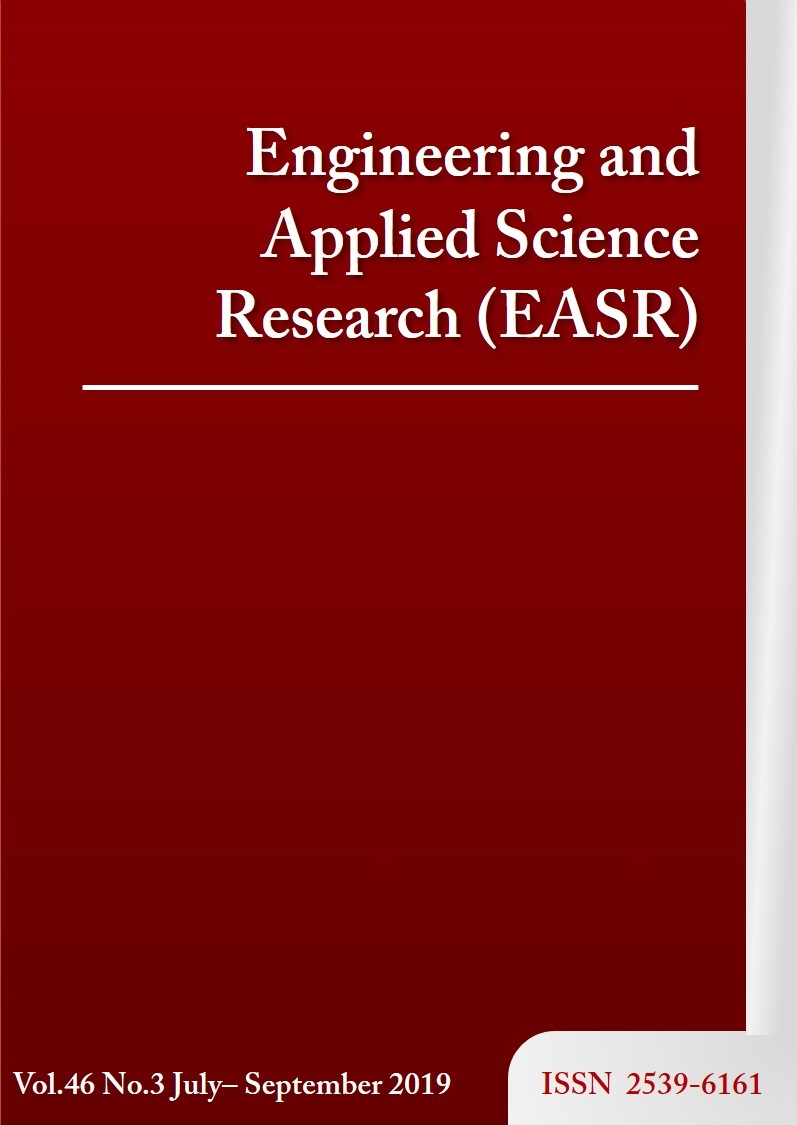Container transport mode choice analysis with a binary logit model case study: Northeastern Thailand
Main Article Content
Abstract
This research aimed to develop a model to forecast container transport mode choice for processed agricultural products including tapioca starch, rice, and sugar from northeastern Thailand. The study applied the stated preference survey technique and developed a binary logit model from the results. It was found that the factors influencing container transport mode choice include transport time, cost, punctuality, availability of scheduling staff, and distance from the factory to railway station. The stated preference questionnaires were distributed, and responses were obtained from 19 manufacturers in the study area. The binary logit model was developed and proved to fit the real dataset. It was able to provide forecast precision to a satisfactory level. The calibrated model was tested with various transport policies to demonstrate possible approaches to improve rail transport mode share and promote a more sustainable freight transportation option.
Article Details
This work is licensed under a Creative Commons Attribution-NonCommercial-NoDerivatives 4.0 International License.
References
[2] Office of The National Economic and Social Development Board [Internet]. The Tenth National Economic and Social Development Plan (2007-2011) [cited 2016 Feb 23]. Available from: http://www3.oae.go.th/.
[3] Danielis R, Marcucci E, Rotaris L. Logistics managers’ stated preferences for freight service attributes. Transport Res E Logist Transport Rev. 2005;41(3):201-15.
[4] Shinghal N, Fowkes T. Freight mode choice and adaptive stated preferences. Transport Res E Logist Transport Rev. 2002;38(5):367-78.
[5] Grue B, Ludvigsen J. Decision factors underlying transport mode choice in European freight transport. Proceedings of the Association for European Transport; 2006 Sep 18-20; Strasbourg, France. West Kensington: Association for European Transport (AET); 2006. p. 1-23.
[6] Kofteci S, Ergun M, Ay HS. Modeling freight transportation preferences: conjoint analysis for Turkish Region. Sci Res Essays. 2010;5(15):2016-21.
[7] Masiero L, Hensher D. Analyzing loss aversion and diminishing sensitivity in a freight transport stated choice experiment. Transport Res Pol Pract. 2010;44(5):349-58.
[8] Arunotayanun K, Polak JW. Taste heterogeneity and market segmentation in freight shippers’ mode choice behaviour. Transport Res E Logist Transport Rev. 2011;47(2):138-48.
[9] Feo M, Espino R, García L. An stated preference analysis of Spanish freight forwarders modal choice on the south-west Europe Motorway of the Sea. Transport Pol. 2011;18(1):60-7.
[10] Samimia A, Kawamura K, Mohammadian A. A behavioral analysis of freight mode choice decisions. Transport Plann Tech. 2011;34(8):857-69.
[11] Masiero L, Hensher DA. Freight transport distance and weight as utility conditioning effects on a stated choice experiment. J Choice Model. 2012;5(1):64-76.
[12] Moschovou TP, Giannopoulos GA. Modeling freight mode choice in Greece. Procedia - Soc Behav Sci. 2012;48:597-611.
[13] Wang Y, Ding C, Liu C, Xie B. An analysis of interstate freight mode choice between truck and rail: a case study of Maryland, United States. Procedia - Soc Behav Sci. 2013;96:1239-49.
[14] Comi A, Donnelly R, Russo F. Urban freight models. In: Lóránt Tavasszy, Gerard de Jong, editors. Modelling freight transport. Oxford: Elsevier; 2014.
[15] Shen G, Wang J. A Freight mode choice analysis using a binary logit model and GIS: the case of cereal grains transportation in the United States. J Transport Tech. 2012;2(2):175-88.
[16] Arencibia AI, Feo-Valero M, García-Menéndez L, Román C. Modelling mode choice for freight transport using advanced choice experiments. Transport Res Pol Pract. 2015;75:252-67.
[17] Feo-Valero M, Arencibia AI, Román C. Analyzing discrepancies between willingness to pay and willingness to accept for freight transport attributes. Transport Res E Logist Transport Rev. 2016;89:151-64.
[18] Indra-payong N. Modal split for freight transportation: A case study of freight transportation between Bangkok and the Eastern of Thailnad [dissertation]. Bangkok: King Mongkut's University of Technology Thonburi; 1998.
[19] Kotler P, Kotler M. Market your way to growth: 8 ways to win. New Jersey: John Wiley & Sons; 2013.
[20] Armstrong G, Kotler P. Marketing and introduction. England: Peason Education; 2015.
[21] Hair J, Black W, Babin B, Anderson R. Multivariate data analysis. 7th ed. New York: Prentice Hall; 2010.
[22] Kline RB. Principles and practice of structural equation modeling. 3th ed. New York: Guilford Press; 2011.
[23] Thailandtrains. Map of Thailand’s North Eastern Train Line [Internet]. 2016 [cited 2018 Oct 23]. Available from:http://www.thailandtrains.com/north-eastern-line-map/.
[24] Hensher DA, Rose JM, Greene WH. Applied choice analysis a primer. USA: Cambridge University Press; 2005.
[25] Ortúzar JdD, Willumsen LG. Modelling transport. 4th ed. United Kingdom: John Wiley and Sons; 2011.
[26] Kroes EP, Sheldon RJ. Stated preference methods. J Transport Econ Pol. 1988;22(1):11-25.
[27] Louviere JJ, Flynn TN, Carson RT. Discrete choice experiments are not conjoint analysis. J Choice Model. 2010;3(3):57-72.
[28] ChoiceMetrics. Ngene 1.2 user manual and reference guide. The cutting edge in experimental design 2018 [Internet]. 2018 [cited 2016 Feb 23]. Available from: www.choice-metrics.com.
[29] Koppelman FS, Ben-Akiva ME. Aggregate forecasting with disaggregate travel demand models using normally available data. In: Visser EJ, editor. Transport decisions in an age of uncertainty. Dordrecht: Springer; 1977. p. 159-66.
[30] Ben-Akiva M, R.Lerman S. Discrete choice analysis: Theory and application to travel demand. USA: MIT Press; 1985.
[31] Koppelman FS, Bhat C. A self instructing course in mode choice modeling: multinomial and nested logit models. USA: Department of Transportation Federal Transit Administration; 2006.
[32] Saeed N. Cooperation among freight forwarders: mode choice and intermodal freight transport. Res Transport Econ. 2013;42(1):77-86.
[33] Kim HC. Developing a mode choice model for New Zealand freight transportation. Christchurch, New Zealand: University of Canterbury; 2014.
[34] Sánchez-Díaz I. Modeling urban freight generation: a study of commercial establishments’ freight needs. Transport Res Pol Pract. 2017;102:3-17.



